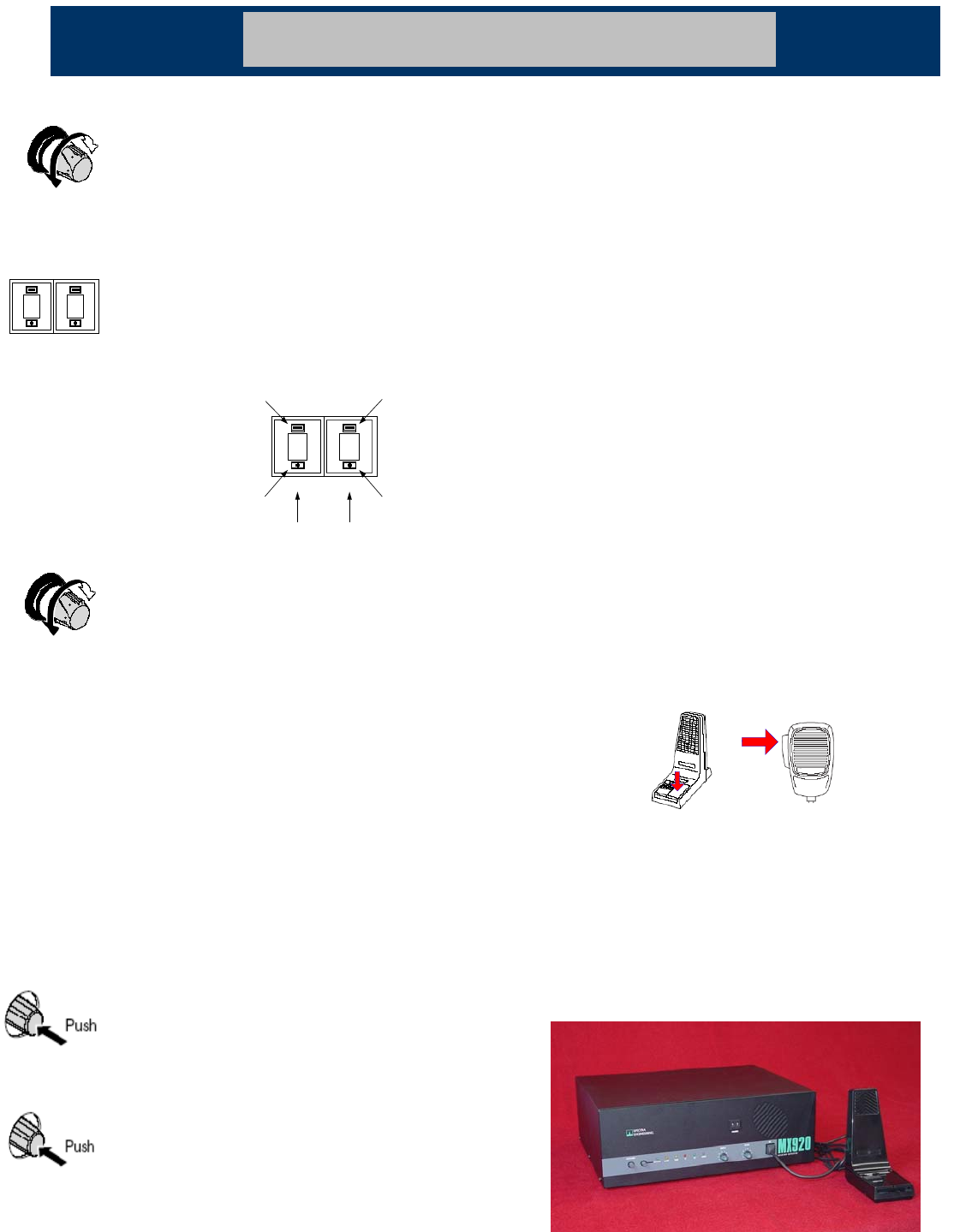Spectra Engineering MX920 Desktop Base Station/Repeater User Manual VOLUME
Spectra Engineering PTY LTD Desktop Base Station/Repeater VOLUME
Users Manual

OPERATION
VOLUME
Rotate the volume control clockwise to adjust the volume control
for a comfortable listening level. If no sound is heard, temporarily
un-mute the radio by briefly rotating the Squelch Control full anti-
clockwise. You can adjust the volume by listening to the receiver's
background noise.
When finished, return squelch setting. (See section on setting
Squelch.)
CHANNEL SELECTING
Push to select the memory channel number for the selected
readout.
The channel display will Rotate and select the higher channel
when the up button is pressed.
By pressing the down button the Channel display will rotate to
display the lower channel selected. The selected channel is
displayed.
SQUELCH
The squelch is used to eliminate any annoying background noise
when there are no signals present.
When no signal is received, rotate the Squelch control (SQL) fully
counterclockwise first, and then rotate SQL clockwise to the point
that the noise just disappears. This will provide optimum Squelch
performance.
When the Squelch is Open, the receiver's background noise can
be heard and 'Green RX LED' is lit on the front panel display.
When the Squelch is closed, the receiver remains quiet when there
are no signals present but any incoming signals will override the
Squelch and be heard in the speaker
NOTE: If an incoming signal is very weak and is close to the
minimum squelch level, it may become broken or “chopped” by the
squelch action. To prevent this, simply open the squelch to allow
the signal to be heard clearly. Alternatively, you can reduce the
squelch sensitivity as described above.
When CTCSS is enabled the channel remains quiet until someone
transmits using the same tone. When the transmission ends, the
channel becomes quiet again. By using different tones, several
groups of people can share the same channel without disturbing
each other.
ACCESSORY SWITCH
The Accessory button is a programmable momentary switch.
Which is assigned a function in software programming. (Subject to
Radios firmware)
See Dealer for application notes for further information on this
feature.
REPEATER SWITCH
This switch enables the MX920 to work as a repeater.
In repeater mode, the received signal is processed and retransmits
at a different frequency.
Repeaters are usually located on hills, mountains or tall buildings.
The increased elevation greatly improves the range of the repeater
beyond that of a normal base or
Mobile. This means that the repeaters are able to receive and
retransmit signals to radios that would otherwise be out of range of
each other.
Receiving A Call
With the MX920 powered ‘ON’ the front panel blue led is lit.
• Set the audio and squelch levels as per SQUELCH
and VOLUME section.
• Select the desired receiving channel as per Channel
selecting section.
• When receiving a signal the ‘Green RX LED‘ indicator
lights green when the squelch is open, and audio is
emitted from the speaker.
• Listen for your call sign when you hear activity, and
reply promptly by identifying yourself if called. (For
example: Base receiving).
Transmitting To Making A Call
With the MX920 powered ‘ON’ the front panel blue led is lit.
• Select the desired channel, as previously described.
• If the ‘Green RX LED' indicator is on, the channel is
busy and you must wait until it is free, before
proceeding. If you attempt to transmit anyway, the
other party may not receive your transmitted signal.
• Lift the microphone off-hook and listen to check that
no one else is using the channel. You may also have
to press the Monitor Key on the desktop Microphone
or the Accessory button on the radio briefly, depending
on the microphone used and the options programmed
to your radio.
• When using the Hand-Held microphone, Hold it about
5cm from your mouth and press the Press-To-Talk
(PTT) key, located on the side of the microphone (see
Figure 3-1). Speak clearly into the microphone at your
normal voice level, identifying yourself by your call
sign, and the person you wish to contact. (For
example: Base to Mobile 2.).
• The ‘Red RX LED’ indicator lights while transmitting.
• Release the PTT key when you have finished talking.
Transmit Timer
Your MX920 is fitted with a preprogrammed timer to limit the
maximum length of transmissions.
When the time limit is reached, the radio sounds a warning tone,
and transmission is terminated. (Subject to Radio Firmware)
0
0
00
UP
CHANNEL
UP
CHANNEL
DOWN
CHANNEL
DOWN
CHANNEL
TEN UNITS UNITS
PTT
PTT
Fi
g
ure 3-1 Fi
g
ure 3-2
__________________________________________________________________________________________
© SPECTRA ENGINEERING 2004 Revision 1.0.0

INSTALLATION
Unpacking
The MX920 Radio is securely packed for transport with special end
packers within a pasteboard container. Before unpacking the MX920
radio, please inspect the packaging for signs of damage and report any
damage to your MX800 distributor.
Upon unpacking of the MX920 radio, please ensure that all items
shipped were received, report any missing items to your MX920
distributor. All ports on the rear of the radio should be carefully examined
to ensure that packaging has not become wedged inside them. It is very
important to examine the fan, as operation of the radio will be affected if
any packaging or shipping damage causes the fan to stop working.
Installing the Base Station System
The MX920 is designed to be used in a stand-alone configuration.
Ensure that it is in a secure, dry location with sufficient air space around
it to allow for adequate ventilation. It is recommended that the chassis be
earthed.
An optional 19inch rack mount tray is available for mounting the repeater
into a 19-inch rack. If you intend to install the radio in an equipment rack
consult the suppliers instructions for your system.
Power Supply
The MX920 has been design to fit an optional internal power supply
(PSU).
It can also be fitted with optional sealed lead acid batteries Kit for a
backup battery.
Automatic Backup Battery Change Over System and charger ONLY
available in the 240V PSU Model. The built-in backup system supports
automatic switching to an external power DC battery supply if the AC
power supply fails.
Make sure the [POWER] switch on the back of the PSU is turned OFF
when connecting an AC power cable and also when connecting the DC
power cable for a backup battery (Refer to the Mains ratings label on the
rear of the PSU module)
Note. If external batteries are used and are non-sealed Lead-acid
batteries type, placement should be at least 4 m away from the repeater.
Be sure both the positive (red) and negative (black) terminals are
correctly connected.
The MX920 will draw approximately 7 to 9Amps (band dependent) on
transmit and when external power supply \ batteries are used, the gauge
of the DC cable fitted to the 12V supply connector should be adequate to
ensure less than 0.5V volt drop at this current.
Antenna
In radio communications, the antenna is critical importance, effecting the
output power and sensitivity.
The antenna and coax cable should be the 50ohm type, and have a
Voltage Standing Wave Ratio (VSWR) of 1.5:1 or better.
CAUTION: Protect repeater from lightning by using a lightning arrestor.
NOTE: There are many publications covering antennas and their
installation. Consult with your local dealer for more information and
recommendations.
SWR
Each antenna is tuned for a specified frequency range and SWR
may be increased if used out-of-range.
When the SWR is higher than approx. 3.0:1, the transceiver’s
power drops to protect the Power Amplifiers final transistor. Low
SWR allows full power for transmitting. The MX920 has a
software diagnostic SWR meter to monitor the Antenna SWR
continuously.
Duplexer
The Mx920 with optional internal duplexer kit provides mounting
for a number of different manufactures duplexers.
A duplexer is required when only one antenna is used for both
transmitting and receiving. Select a duplexer according to the
transmitting and receiving frequencies.
See Dealer for further information on this feature
Software Programming
The MX920 can operate in a number of different modes. The
primary alternatives are full duplex, which is the default mode,
repeater and simplex. Using the built-in radio configuration menu
system, the operating mode is programmed for each channel.
There are a number of features that also can be enable/disabled
to suit the individual system needs. This is done thought the
built-in radio configuration menu system, and with Personal
Computer (PC) with terminal software.
Note: All MX920s’ are set up with a standard configuration and
test frequency as supplied from Spectra’s factory.
See Dealer for application notes for further information on this
feature.
Diagnostic
The MX920 has built in software to allow the user to monitor the
current state of the radio.
See Dealer for application notes for further information on this
feature.
You will require a Personal Computer (PC) with terminal
software to monitor this.
__________________________________________________________________________________________
© SPECTRA ENGINEERING 2004 Revision 1.0.0